Behavioural Management
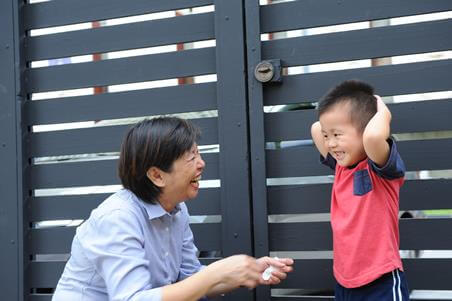
"Behaviour management" might sound like a fancy term for the usual disciplinary methods, but the two are not the same. Discipline involves teaching children right from wrong, and includes methods to prevent or respond to behaviour problems so they do not occur in the future - for example, training a child to act according to rules of conduct and a set of rules and regulations.
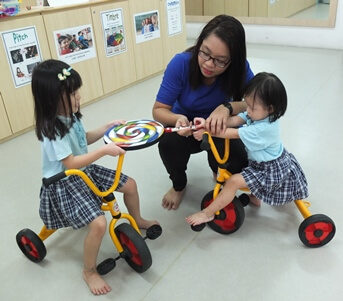
"Discipline is a set of expectations that help children behave appropriately in different situations," explains Early Childhood and Special Education Consultant and Training Specialist Puspa Sivan.
In contrast, behaviour management - sometimes referred to as behaviour modification - is about helping children change their negative behaviours and habits. "It is a process in guiding children towards good and acceptable behaviour. The process involves identifying the negative behaviour, providing avenues for alternative behaviours, changing the environment to reduce negative behaviour and providing positive reinforcement to encourage appropriate behaviour. It is basically a set of systems in place to manage the behaviour."
RECOGNISE THE BEHAVIOUR
Ms Sivan identifies four common behavioural problems:
- Aggressive Behaviour, such as biting, shoving, kicking and hitting;
- Destructive Behaviour, such as breaking the toys of other children or destroying the work of others;
- Disruptive Behaviour, such as creating a ruckus during family or school routines or disturbing others; and
- Withdrawn Behaviour, such as when a child only wants to be left alone or does not want to participate in any group activities.
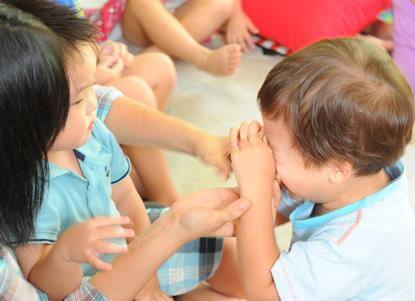
However, knowing when to apply the appropriate behaviour management strategies requires an understanding of children's behaviour at different developmental stages, and knowing when certain behaviour has progressed to problematic degrees. "Certain behaviours are expected as part of the developmental stage the child is at," says Ms Sivan. Using an example to illustrate when a behaviour becomes a problem, she shares: "During toddler age, one can expect biting or snatching behaviours to be common as toddlers have yet to acquire the language to express verbally."
"[At this age] they tend to be more action-oriented when they want something as they are unable to express verbally. But biting can be a problem even at a toddler age - when it occurs frequently and with intensity. If the behaviour of the child affects others around them and becomes an issue for both the parents and teachers at the centre, then it is cause for concern.
"Parents and teachers have to observe and keep track of inappropriate behaviours so that they can apply the right strategy to modify the behavioural issue."
USEFUL STRATEGIES
There are two steps in managing your child's behaviour:
- Identifying the problem, and;
- Deciding on the goals and course of action.
For a start, observe your child's behaviour over a period of time to identify the following:
- The times when a specific behaviour occurs (e.g. during free play, during story time, during mealtimes)
- The specific behaviour (e.g. biting, snatching, throwing a tantrum)
- The consequences of the specific behaviour (e.g. response from the adults towards the child when the behaviour occurs, either from the parents or teacher)
"Gathering information on the above will give a good idea of the pattern of the child's behaviour. It will help you identify what triggers the behaviour and whether the current consequence applied is effective or it is aggravating the situation," explains Ms Sivan. "For example, when the child bites someone, the parent can attend to the victim and ignore the child, rather than reprimand him or her as a consequence."
"Sometimes as adults, we inevitably reinforce the negative behaviour by giving 'attention' to the child. By attending to the victim, consoling and empathising with him or her, helps the child (with the errant behaviour) realise that he is not getting attention when he does something inappropriate."
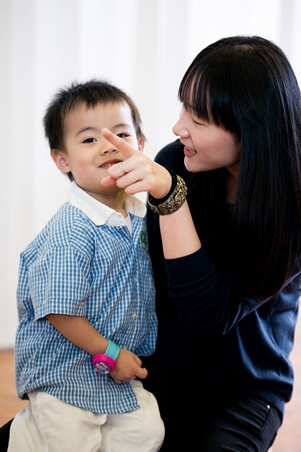
A consistent approach in responding to the child's behaviour has to be adopted by all the adults in that environment to make it effective. Yet behaviour management is not just about correcting a child's errant ways, but helping him or her identify the desirable behaviours. This means adults should be just as vigilant in "catching" children doing good and immediately reinforcing the good behaviour. "If this is done consistently the child soon realises that good behaviour begets attention while bad behaviours gets him or her ignored."
BE IMMEDIATE, BE SPECIFIC
Ms Sivan also believes in highlighting positive behaviours or actions to the child. "For example, if the child is playing well with his cousin at home, the parent can immediate say "Wow! You are very caring towards your cousin and your cousin is very happy." By doing this, the child gets attention in the right way and his or her good behaviour is reinforced.
She also points out that positive reinforcement for good behaviours can be done in many ways: from stickers to privileges such as longer play time at the playground. "Some parents give social reinforces such as smiling, patting the child or hugging the child or by praising the child," says Ms Sivan.

"There is a technique to praising too: Praising the action of the child. As parents, we always say 'good boy' or 'good girl' but children need to know what they are being praised for, for example: "I like the way you helped Mummy put away the toys' or 'I am very happy to see you sharing your toys with your sister'." The positive reinforcement has to be immediate to be effective. When we do that, the good behaviour is reinforced and children are motivated to repeat the same behaviour."
BE THE ROLE MODEL
Apart from identifying the problem and finding appropriate responses, parents should also be aware of how their own actions influence on the child. "Children learn behaviours by observing, modelling and imitating. For example, of a parent reprimands a child for hitting his younger sibling by beating him, the adult is modelling aggressive behaviour," says Ms Sivan. This also means not to give children careless responses: "There have been cases where parents tell their children to 'bite back' in response to a classmate's biting behaviour. In this case, what we are teaching our children is that it is alright to indulge in aggressive behaviours."
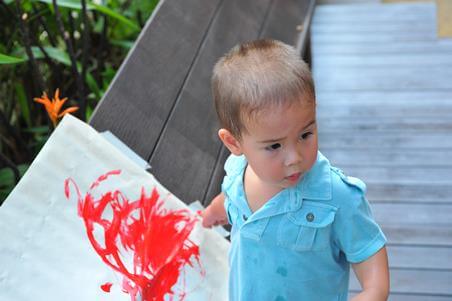
"Children closely observe their parents' behaviour on a daily basis," highlights Ms Sivan. "We must make a conscious effort to be good role models for our children. How we speak, how to respond to situations and how we care for others - these dispositions are most effectively cultivated in our children through our examples in daily life".
You may also like

From Cabin to Classroom: Journey of an Outstanding Early Childhood Educator
The PDP modules allowed me to get creative with lesson ideas and keep up with the ever-changing Early Childhood sector.

Ms Farhana Binte Mohamed Hassan
Early Years Educator - PCF Sparkletots @ Pioneer Block 987D (CC)

More Than Just a Place for Food
Young children are highly inquisitive, and learn most effectively with activities that allow exploration and experimentation.

Kinderland @ Yio Chu Kang

Little Fingers Create Great Art - A Community Project by Kinderland and Skool4kidz
I believe this collaborative effort is a very meaningful contribution to the SG50 celebrations.

Kinderland and Skool4Kidz